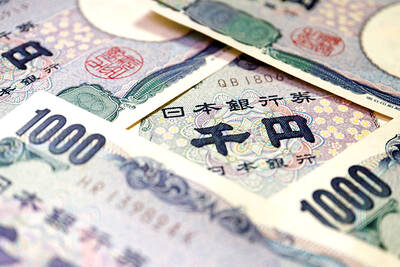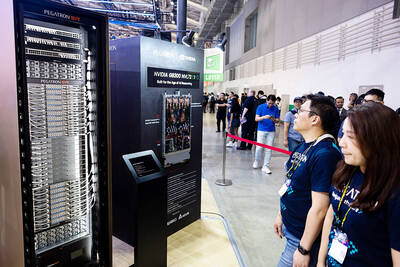Memory module supplier Adata Technology Co (威剛科技) yesterday said that contract prices for NAND flash memory are expected to rebound this quarter, following an uptrend in DRAM prices.
However, supply constraints would carry into next quarter, as recovering demand from automakers adds pressure to an industry beset by strong demand for notebook computers, smartphones and data centers, Adata said.
DRAM prices are expected to climb steadily after a trough at the beginning of December last year, with more marked hikes next quarter, Adata chairman Simon Chen (陳立白) said.

Photo: CNA
A severe supply crunch is expected in the second half of this year, Chen said.
The company, which is based in New Taipei City’s Sindian District (新店), said that it has built at least two months of DRAM chip inventory for its own use.
Adata’s financial performance this quarter would be significantly better than last quarter, Chen said.
Higher shipments of solid-state drives (SSD) have helped, he said.
The company’s revenue for last month grew 12.27 percent to NT$2.81 billion (US$99.41 million), compared with NT$2.5 billion in February last year, aided by a rise in DRAM prices and improved demand for NAND memory chips for SSD storage, Adata said in a statement.
On a monthly basis, revenue fell 4 percent from NT$2.93 billion.
DRAM products accounted for about 40 percent of the company’s total revenue last month, SSD products contributed 42 percent, and memory cards, flash drives and other items made up 16 percent, it said.
“Since the beginning of this year, customers have been placing orders aggressively,” Adata said. “Employees worked overtime during the Lunar New Year holiday to satisfy demand.”
The company said that it is bullish about this year’s business outlook, citing robust demand.
In the first two months of this year, revenue jumped 32.26 percent to NT$5.74 billion from NT$4.34 billion in the same period last year.
DRAM chipmaker Nanya Technology Corp (南亞科技) on Wednesday reported that last month’s revenue was its highest in 28 months, driven by higher prices.
Revenue rose 26.91 percent to NT$5.79 billion, from NT$4.56 billion in February last year, and grew 4.68 percent from NT$5.53 billion in January, Nanya said.
Nanya president Lee Pei-ing (李培瑛) in January said that he expected a DRAM price uptrend to continue throughout the first half of this year, and it might extend into the second half as the COVID-19 pandemic-driven stay-at-home economy, as well as a chip shortage, boosts DRAM consumption for notebook computers, tablets, networking devices and game consoles.

AI TALENT: No financial details were released about the deal, in which top Groq executives, including its CEO, would join Nvidia to help advance the technology Nvidia Corp has agreed to a licensing deal with artificial intelligence (AI) start-up Groq, furthering its investments in companies connected to the AI boom and gaining the right to add a new type of technology to its products. The world’s largest publicly traded company has paid for the right to use Groq’s technology and is to integrate its chip design into future products. Some of the start-up’s executives are leaving to join Nvidia to help with that effort, the companies said. Groq would continue as an independent company with a new chief executive, it said on Wednesday in a post on its Web

RESPONSE: The Japanese Ministry of Finance might have to intervene in the currency markets should the yen keep weakening toward the 160 level against the US dollar Japan’s chief currency official yesterday sent a warning on recent foreign exchange moves, after the yen weakened against the US dollar following Friday last week’s Bank of Japan (BOJ) decision. “We’re seeing one-directional, sudden moves especially after last week’s monetary policy meeting, so I’m deeply concerned,” Japanese Vice Finance Minister for International Affairs Atsushi Mimura told reporters. “We’d like to take appropriate responses against excessive moves.” The central bank on Friday raised its benchmark interest rate to the highest in 30 years, but Bank of Japan Governor Kazuo Ueda chose to keep his options open rather than bolster the yen,

Even as the US is embarked on a bitter rivalry with China over the deployment of artificial intelligence (AI), Chinese technology is quietly making inroads into the US market. Despite considerable geopolitical tensions, Chinese open-source AI models are winning over a growing number of programmers and companies in the US. These are different from the closed generative AI models that have become household names — ChatGPT-maker OpenAI or Google’s Gemini — whose inner workings are fiercely protected. In contrast, “open” models offered by many Chinese rivals, from Alibaba (阿里巴巴) to DeepSeek (深度求索), allow programmers to customize parts of the software to suit their

Global server shipments are expected to surge to 15 million units next year, from 4 million units this year, with artificial intelligence (AI) servers accounting for about 30 percent, driven by massive capital spending by major cloud service providers, the Market Intelligence and Consulting Institute (MIC) said on Thursday last week. Major cloud service providers — including Google’s parent company Alphabet Inc, Microsoft Corp, Amazon.com Inc and Meta Platforms Inc — are projected to budget US$450 million for capital expenditure next year, up from US$400 million this year, MIC ICT [information and communications technology] Industry Research Center director Edward Lin